Welcome to the South Atlantic
Published on January 12th, 2015
(January 12, 2015; Day 13) – Lead by Hugo Boss at 0150hrs UTC this Monday morning, four IMOCA 60s of the Barcelona World Race fleet are now racing south in the Southern Hemisphere after crossing the equator in relatively quick succession.
After Alex Thomson and Pepe Ribes came their team-mates from the Alex Thomson Racing ‘scuderia’ Neutrogena, sailed by Guillermo Altadill and José Muñoz, who breached the Equator 1hr and 10 minutes later, about 50 miles to the west of Hugo Boss. Two and a half hours after Hugo Boss, and in the wake of Neutrogena, it was BernardStamm and Jean Le Cam who crossed on Cheminees Poujoulat. Then at 1020hrs UTC this morning – just 8hrs 30mins after Hugo Boss – Anna Corbella and Gérard Marin, passed over the Equator too on GAES Centros Auditivos.
Hugo Boss bettered the 2010-11 edition time, Barcelona to the Equator, by 25 hours, thanks to the combination of good NE’ly trade winds since the Canary Islands and a relatively easy passage through the Doldrums. Thomson and Ribes had their wobbles, spells yesterday in light airs which they had to wriggle clear of, but this afternoon they were making 12kts in 15kts of SE’ly trade winds.
Now it is drag race, a boatspeed contest to get south, as Alex Thomson explained today:
“It was a tough Doldrums crossing, much tougher than we thought it would be, but we have come out about 50 miles to windward, hopefully we will convert that over the next period of a week to ten days to 50-60-70 miles of forwards advantage. We have about 15-20kts, tight reaching, relatively big seas, a few slams. We have had a lot of rest after the Doldrums. Now it is a bit of a drag race, a boat speed race, while we consider our options for the routing as we get further down and towar ds the south where we will turn left into the Southern Ocean. All’s going well and we are Super Happy.”
Speaking this morning Spanish co-skipper Pepe Ribes confirmed that they had stuck to their game plan rather than make any alterations when they saw their two rivals diverge behind them to make some westing.
Leading into the Doldrums is never easy and they did feel some compression when they were slowed and Neutrogena and Cheminées Poujoulat could alter their course as the leaders had effectively flagged a calm area for them. Such are the perils of breaking into lighter airs as pacemaker.
But Ribes added that he and Thomson are happy with the leverage he feels they have gained being effectively 50 miles to windward of their rivals in the SE’ly winds. If they want to, he explained, they can sail lower and faster to cover any advance that Cheminées Poujoulat and Neutrogena make. Ribes speaks with the knowledge that their boat should be proportionately quicker:
“Recently they got a little closer to us, but we are in a good position, with a big windward advantage that we’re going to use when conditions are good enough for us to go faster. We must know how and when to profit from it. We need to see when it is that we can put the pedal down.”
GAES Centros Auditivos are fighting back with good speeds today too. Their slowdown when they had to sail with no mainsail cost them a few miles but the immediate future of Renault Captur encourages debate. Jorg Riechers and Sébastien Audigane were recovering on a more westerly course this afternoon after being stuck in the east yesterday.
Riechers declared today that their option is 70 per cent precipitated by choice and 30 per cent by circumstances.
Their position, 140 miles still to the equator, may have to get worse before it gets better, relative to the boats in front. The German co-skipper re-affirmed the need to do something different when you are behind the main pacemaker group, but believed that they would be out of the Doldrums later this morning. That said they are making 9 knots this afternoon, but actually have We Are Water and One Planet One Ocean less than 100 miles behind them, in terms of north south.
The two Barcelona IMOCA 60s are enjoying t heir own spirited duel, a tussle to the Equator, with the older One Planet One Ocean Pharmaton clinging on 12 miles ahead and to the west of the Garcia brothers We Are Water, both duos now feeling the effect of the Doldrums now.
After removing a net or similar textile material from their keel, life is rosier for Spirit of Hungary, Nador Fa and Conrad Colman. They are trundling south at 13-15kts in 16kts of NE’ly trade winds, less than 50 miles NW of the Cape Verde islands, ready to pass about 60 miles to the west of the archipelago.
Skippers Quotes
Jorg Riechers (GER), Renault Captur:
We came into the Doldrums yestrerday and until today still had some wind, I thought we started to break out of the Doldrums in the night, in the late evening, we had the SE wind kick in and then it died away and it was back to the NE wind and now we can see the trade winds clouds on the horizon to the south of us and so I think probably we will break out of the Doldrums in the next few hours. Hopefully. Our strategy was based on two things. We saw that the trade winds were really quite far south and so things were really not very normal, as they should be, so we thought there might be a passage a little boit more east which looked good on the weather charts. Normally it is a little bit crazy to try and cross at 24 or 25 west. But it seems in these special circumstance it seems it might be an option, because you get such a good angle when you come out, we would have 200 miles of leverage on the other boats, so we can sail deeper and faster. So the east can be good. And the decision was also based a little by he fact we had the rudder problem just before the Cape Verde islands and we damaged our Code 5 so we had to sail a little bit higher and that defined our approach to the Doldrums as well. So it was 70 per cent tactical thinking and 30 per cent circumstances. Well, if we were to get out of the Doldrums now then I am confident it would be a big success. Now we have to wait and see until we break out. In any case because of our halyard problem a little after the start, then we lost contact with the leading group, so if you are slightly behind you have to do something. That is what we have done. It was a calculated risk. It seemed like the best option to us.
Pepe Ribe (ESP) Hugo Boss:
Doldrums
The Doldrums were alright for us. With the Doldrums you never know. I think we had a plan before the Doldrums and we stuck to the plan. And the good thing is to come out 50 miles to windward of them (Neutrogena). At the moment we are not sure, the breeze is puffy, the conditions are good. We are having a good time.
The St Helena High
We have to go around the high, these are early stages just now for that the main goal is to go south.
Renault?
I think it is a very risky option to try to pass in the east where Renault are, the boats behind them are only 150 miles or so behind and so if they dont have it really good, maybe he can be passed by the other boats. It is a very risky option.
Life/news outside the boat?
I like to know that everyone is OK and beyond that who is winning in the football, That is always important. But that is about it.
Note: With the next waypoint off the Cape of Good Hope, the rankings below could prove to be misleading as certain teams work west to avoid the Saint Helena high pressure area in the South Atlantic. Click on tracker to confirm positions.
Ranking at 14:00 UTC:
1. Hugo Boss (Alex Thomson – Pepe Ribes) 21101.2 nm Distance to Finish
2. Neutrogena (Guillermo Altadill – Jose Muñoz 54.9 nm Distance to Lead
3. GAES Centros Auditivos (Anna Corbella – Gerard Marin) 58.6 nm DTL
4. Renault Captur (Jörg Riechers – Sebastien Audigane) 69.1 nm DTL
5. Cheminées Poujoulat (Bernard Stamm – Jean Le Cam) 76.5 nm DTL
6. We Are Water (Bruno Garcia – Willy Garcia) 232.4 nm DTL
7. One Planet One Ocean / Pharmaton (Aleix Gelabert – Didac Costa) 235.0 nm DTL
8. Spirit of Hungary (Nandor Fa – Conrad Colman) 810.1 nm DTL
Report by event media.
Background: The third edition of the Barcelona World Race is the only double-handed, non-stop, round the world race. Eight IMOCA 60 teams started December 31, 2014, with the intent to cover 23,450 nautical miles in a circumnavigation from Barcelona to Barcelona, putting the capes of Good Hope (South Africa), Leeuwin (Australia) and Horn (Chile) to port and the Antarctic to starboard. The finishes are forecasted for the end of March 2015.


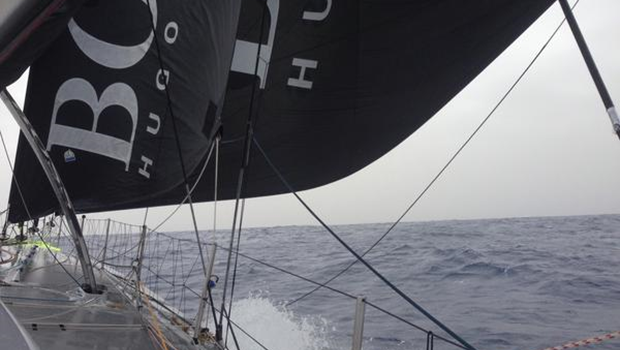


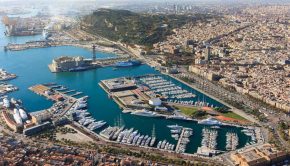
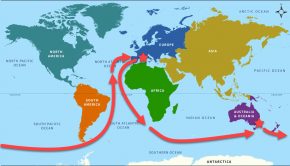
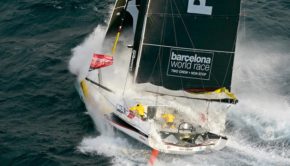
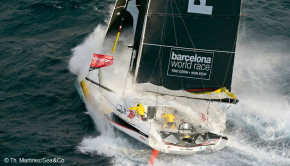
 We’ll keep your information safe.
We’ll keep your information safe.